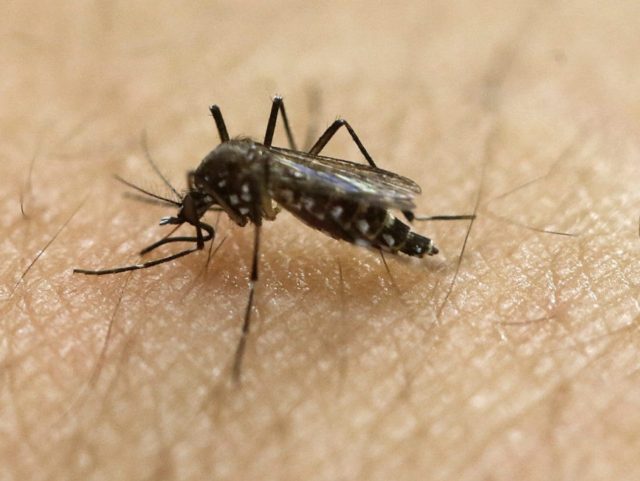A newly released video explains how outbreaks of deadly insect-borne diseases in the United States are linked more to reductions in the application of the pesticide DDT than to global warming.
The video, published by nonprofit public policy research institute Just Facts, describes the research the institute did this year on the claim by Politico that the surge in deadly insect-borne diseases is due to “warming global temperatures.”
Just Facts reported:
For a special issue of Politico about “planetary health,” reporter Christina Animashaun created a graphic on “climate change and human disease” that states:
Warming global temperatures are changing the range and behavior of disease-carrying insects like mosquitos and ticks and extending the seasons in which they are active. As a result, incidence of the diseases they carry—including Lyme, spotted fever, West Nile and malaria—are all on the rise, despite yearly fluctuations.
However, as the research institute points out, the “U.S. Global Change Resource Program’s Climate Health Assessment” the Politico author cites does not actually support her claim.
“Though there are links between climate and tick distribution, studies that look for links between weather and geographical differences in human infection rates do not show a clear or consistent link between temperature and Lyme disease incidence,” the assessment states.
In fact, the Climate Health Assessment minimizes the ability to predict the effects of climate change alone on deadly insect-borne diseases due to its interaction “with many other factors, including how pathogens adapt and change, the availability of hosts, changing ecosystems and land use, demographics, human behavior, and adaptive capacity.”
“These complex interactions make it difficult to predict the effects of climate change on vector-borne diseases,” the assessment notes.
Additionally, the assessment contradicts Politico in its discussion of Western Equine Encephalomyelitis Virus (WEEV) and St. Louis Encephalitis Virus (SLEV).
“Despite climatic warming that would be expected to favor increased WEEV and SLEV transmission, both viruses have had sharply diminished incidence during the past 30 to 40 years,” the assessment states. “Several other mosquito-borne pathogens, such as chikungunya and dengue, have grown in importance as global health threats during recent decades; however, a link to climate change induced disease expansion in the United States has not yet been confirmed.”
Just Facts observed that a 2016 study of coastal U.S. mosquito populations found many studies that show a positive correlation between temperature and insect populations have dismissed the influence of land use and the effectiveness of pesticide DDT prior to its prohibition.
The study, published in the journal Nature Communications, observed:
The recent emergence and spread of vector-borne viruses including Zika, chikungunya and dengue has raised concerns that climate change may cause mosquito vectors of these diseases to expand into more temperate regions. However, the long-term impact of other anthropogenic factors on mosquito abundance and distributions is less studied. Here, we show that anthropogenic chemical use (DDT; dichlorodiphenyltrichloroethane) and increasing urbanization were the strongest drivers of changes in mosquito populations over the last eight decades in areas on both coasts of North America.
A 2000 article by Amir Attaran and Rajendra Maharaj in the British Medical Journal similarly noted the social environmentalist campaign to ban DDT was never based on any studies that actually demonstrate adverse health effects caused by the pesticide:
Although hundreds of millions (and perhaps billions) of people have been exposed to raised concentrations of DDT through occupational or residential exposure from house spraying, the literature has not even one peer reviewed, independently replicated study linking exposure to DDT with any adverse health outcome.
…
We conclude that the public health benefits of DDT amply outweigh its health risks—if, indeed, such risks exist at all. For doctors or their banner groups such as Physicians for Social Responsibility to campaign otherwise is not only wrong but outrageously unethical.
Astronautical engineer Dr. Robert Zubrin also wrote at National Review in 2016 when the Zika virus emerged that “the most effective pesticide is DDT.”
Explaining the history of the campaign to ban DDT, Zubrin wrote about its connection to population control activists:
Much better ammunition was provided by Rachel Carson, who in her 1962 book, Silent Spring, made an eloquent case that DDT was endangering bird populations. This was false. In fact, by eliminating their insect parasites and infection agents, DDT was helping bird numbers to grow significantly. No matter. Using Carson’s book and even more wild writing by Population Bomb author Paul Ehrlich (who in a 1969 Ramparts article predicted that pesticides would cause all life in the Earth’s oceans to die by 1979), a massive propaganda campaign was launched to ban DDT.
In 1971, the newly formed Environmental Protection Agency responded by holding seven months of investigative hearings on the subject, gathering testimony from 125 witnesses. At the end of this process, Judge Edmund Sweeney issued his verdict: “The uses of DDT under the registration involved here do not have a deleterious effect on freshwater fish, estuarine organisms, wild birds, or other wildlife … DDT is not a carcinogenic hazard to man.”
No matter. EPA administrator William Ruckelshaus (who would later go on to be a board member of the Draper Fund, a leading population-control group) chose to overrule Sweeney and ban the use of DDT in the United States. Subsequently, the U.S. Agency for International Development adopted regulations preventing it from funding international projects that used DDT.
“Together with similar decisions enacted in Europe, this effectively banned the use of DDT in many Third World countries,” Zubrin noted. “By some estimates, the malaria death toll in Africa alone resulting from these restrictions has exceeded 100 million people, with 3 million additional deaths added to the toll every year.”

COMMENTS
Please let us know if you're having issues with commenting.